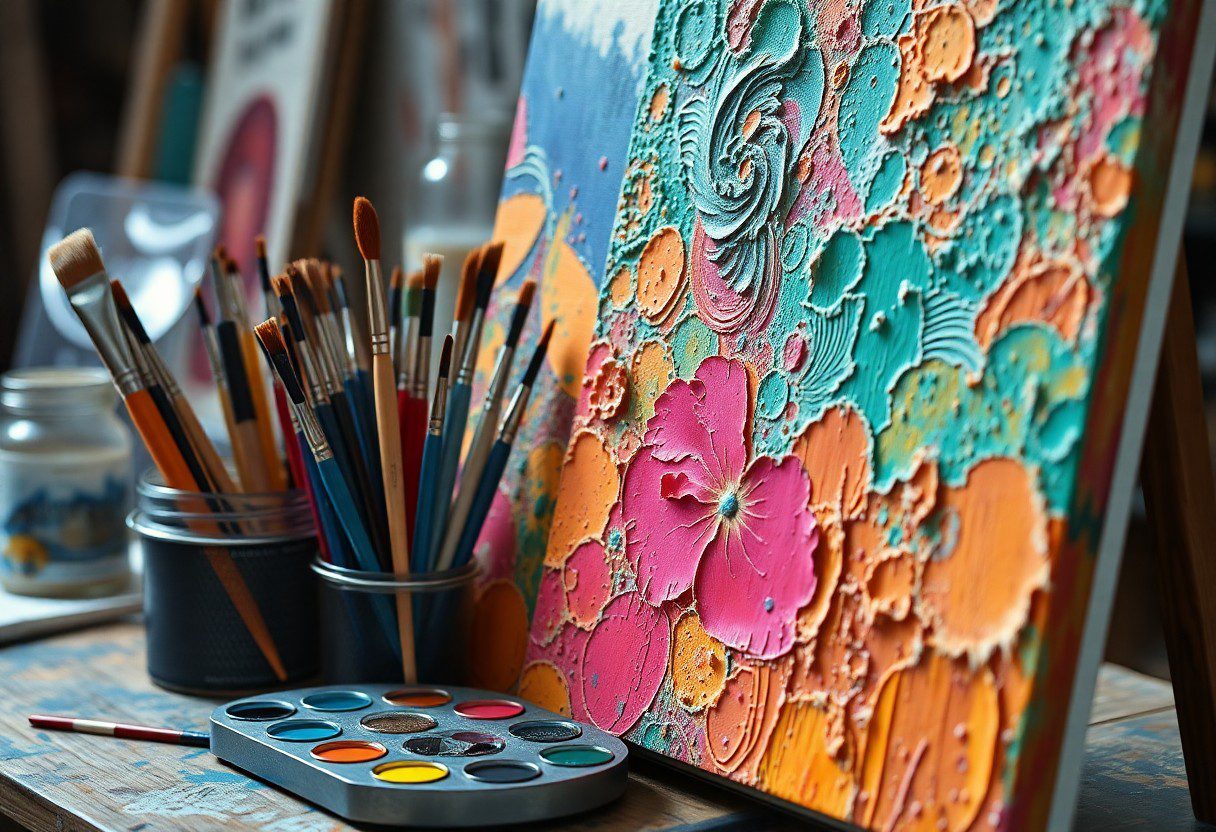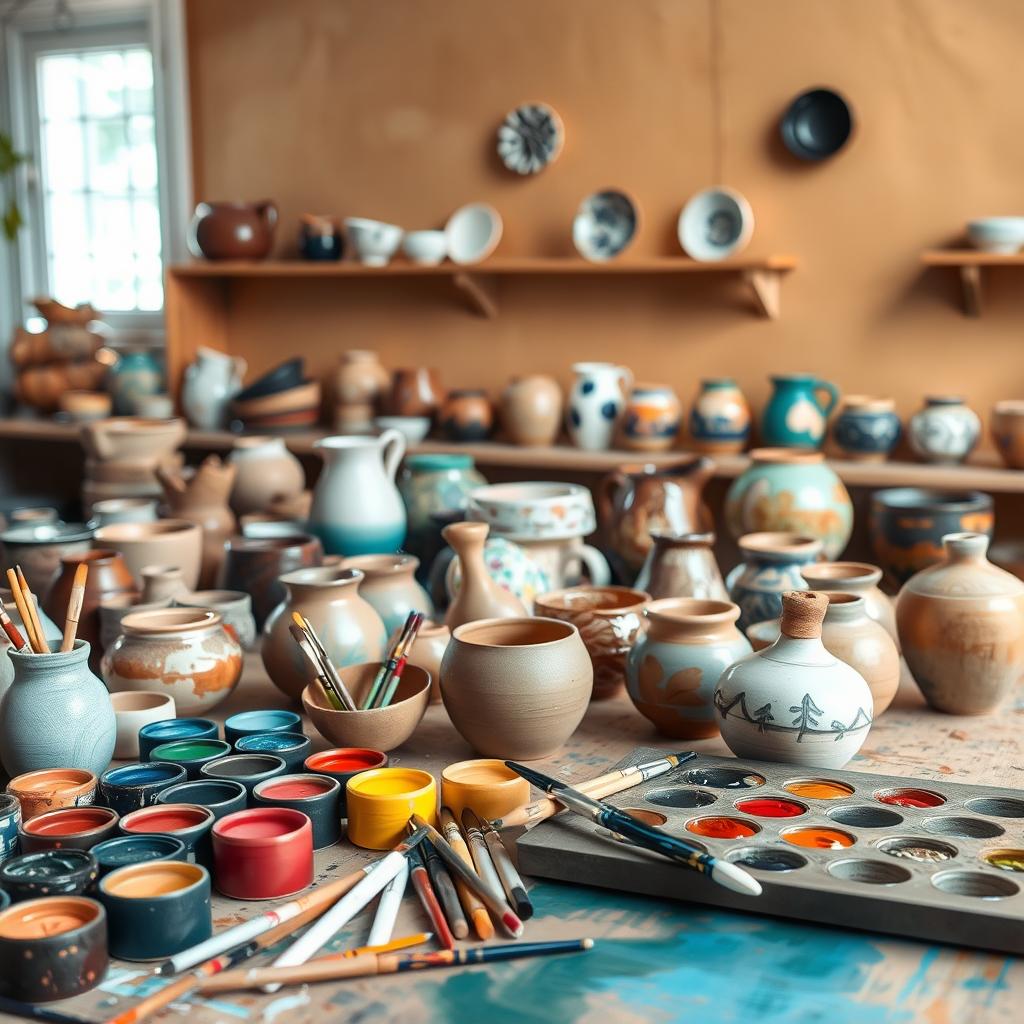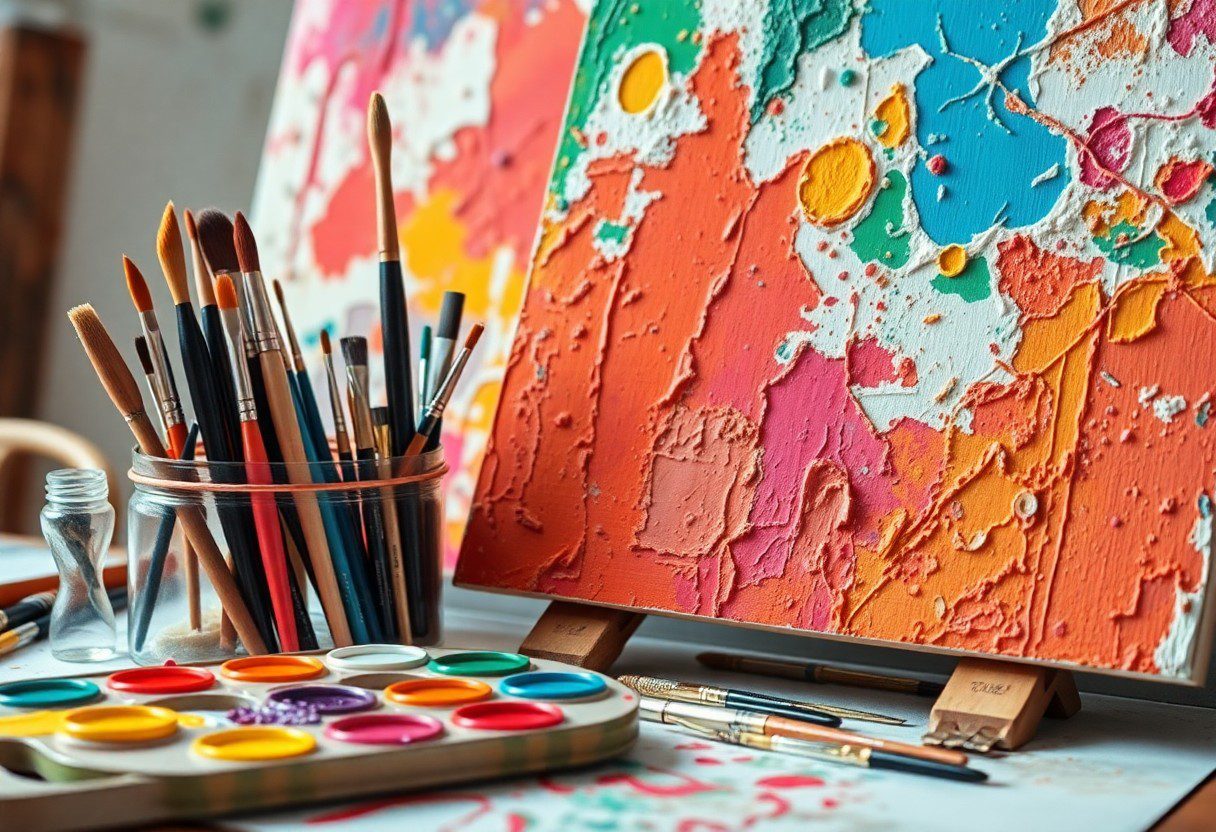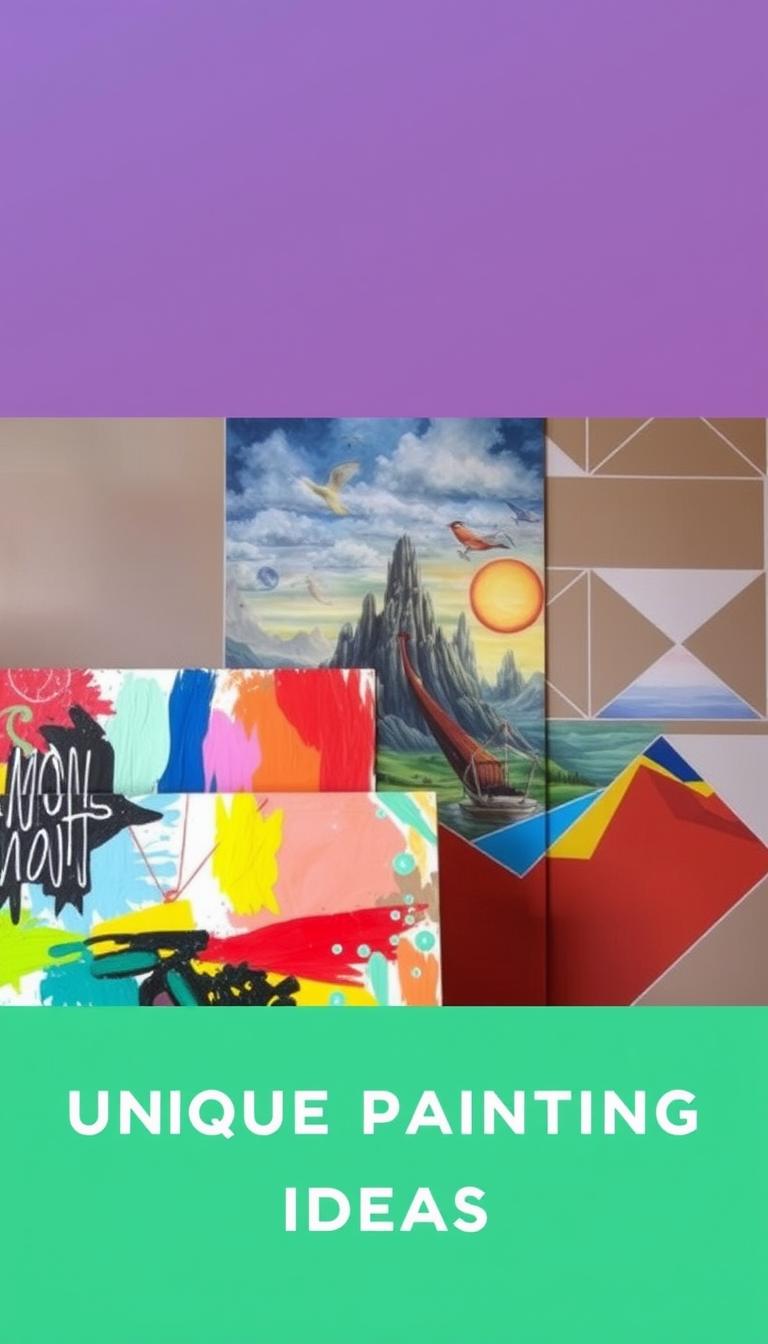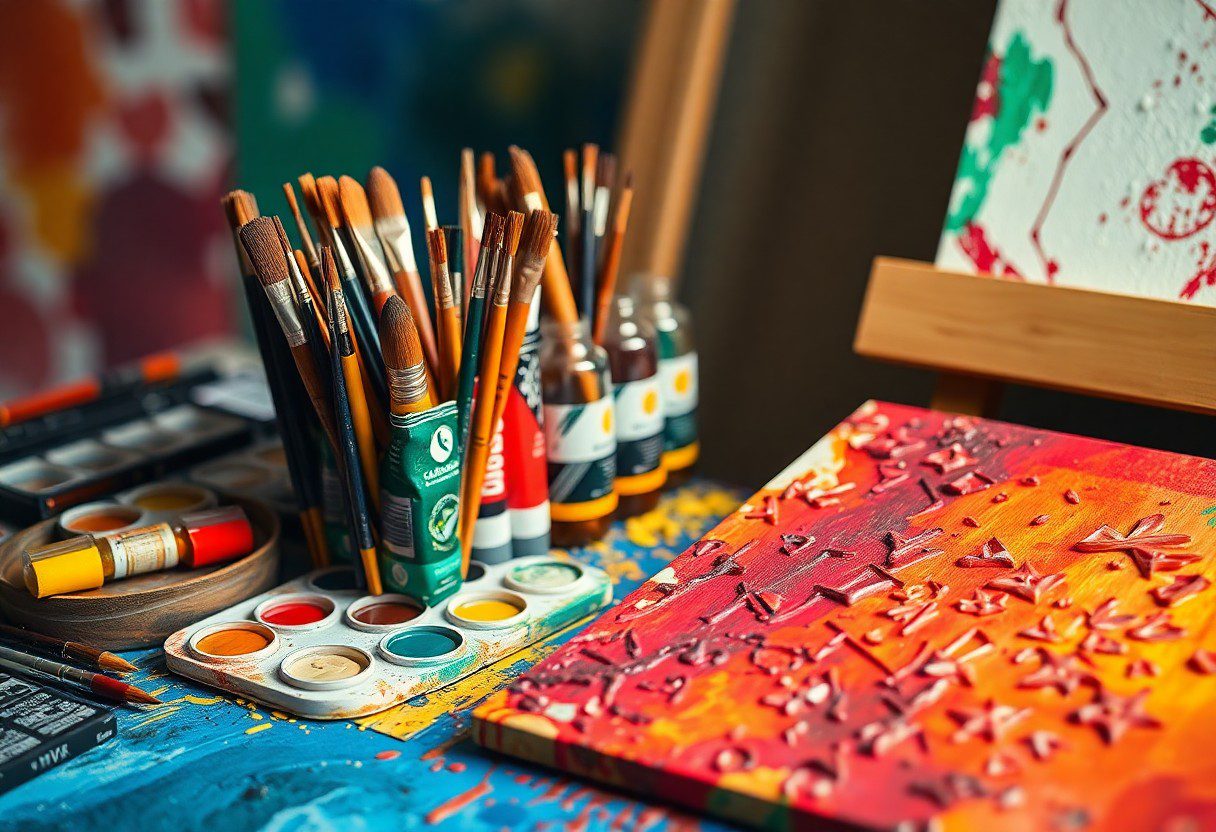With your acrylic art journey in mind, mastering texture can significantly enhance your work’s depth and interest. By incorporating varied techniques and experimenting with tools, you will create dynamic surfaces that captivate viewers. From layering paint to utilizing unconventional materials, these tips will empower you to push the boundaries of acrylic painting. Dive into the world of texture, and watch your artwork transform into a vibrant expression of your creativity!
Understanding Texture in Acrylics
Acrylics offer a unique capability to create stunning textures that can elevate your artwork. Understanding the role of texture in your painting process is fundamental to enhance the sensory experience and visual depth of your pieces. By exploring texture, you can convey a range of emotions and themes, enriching your artistic narrative.
Definition and Importance
Beside enhancing visual interest, texture adds a physical dimension that can engage viewers on a deeper level. It plays a vital role in the overall composition, guiding the observer’s eye and creating a tactile experience that transforms a flat surface into an engaging work of art.
Types of Texture Techniques
The methods to create texture in acrylics are diverse, allowing you the freedom to experiment with various styles. Some popular techniques include:
- Impasto – applying thick layers of paint for a raised effect
- Sgraffito – scratching through layers to reveal underlying colors
- Sponging – using a sponge for soft, mottled effects
- Stippling – applying small dots of paint for intricate patterns
- Texture Paste – mixing medium for added dimension
This variety opens doors for creativity in your acrylic work.
| Texture Technique | Description |
| Impasto | Thick paint application for depth. |
| Sgraffito | Scratching to uncover layers. |
| Sponging | Mottled textures using a sponge. |
| Stippling | Creating patterns with dots. |
| Texture Paste | Medium for enhancing texture. |
Acrylics offer numerous ways to incorporate texture into your artwork, allowing for unique visual effects. You can also combine techniques for more complex results. Delve into these methods, and you’ll discover the transformative power of texture:
- Layering – building textures through multiple layers
- Collage – incorporating mixed media for variety
- Glazing – applying thin layers for depth
- Dry Brushing – applying paint with a dry brush for a scratched look
- Using Tools – experimenting with palette knives or combs
This exploration will enhance your capability as an artist and help you refine your style.
| Technique | Best Practices |
| Layering | Allow drying between layers. |
| Collage | Mix appropriate adhesives. |
| Glazing | Thin down paint appropriately. |
| Dry Brushing | Use a stiff brush for texture. |
| Using Tools | Test on scrap materials first. |
Essential Tools for Creating Texture
Assuming you want to elevate your acrylic painting skills, understanding the important tools for creating texture is key. By selecting the right tools, you can add depth and dimension to your artwork, making every piece stand out. This chapter will guide you through the brush and palette knife options as well as various texture mediums and additives to enhance your creative projects.
Brushes and Palette Knives
Tools like brushes and palette knives serve as your primary instruments for sculpting texture on the canvas. Each brush type offers a different technique, from soft bristles for smooth applications to stiffer ones for creating bold strokes. Palette knives, on the other hand, enable you to apply thick layers of paint, providing a unique and dynamic approach to texture.
Texture Mediums and Additives
Across your artistic journey, incorporating texture mediums and additives into your acrylic paint can significantly enhance your work. These products can modify the consistency and finish of your paint, offering you new ways to interact with your canvas.
Creating texture with mediums such as gel mediums or modeling paste allows you to build up layers and achieve stunning three-dimensional effects. Additionally, additives like sand or glass beads can be mixed into your paint, further enhancing the visual interest in your artwork. These techniques not only improve the overall appearance of your pieces but also add a tactile quality that invites viewers to engage more deeply. Always take care when handling these materials, as some may require proper ventilation or safety precautions. Incorporating these elements into your practice will undoubtedly elevate your artistic expression.
Basic Texture Techniques
Even as a beginner, you can enhance your acrylic paintings by experimenting with basic texture techniques. These methods allow you to add depth and interest to your artwork, transforming flat surfaces into dynamic compositions. By incorporating texture into your painting, you engage your audience and create a unique visual experience that draws the eye and invites exploration.
Impasto Application
Texture in the form of impasto application involves laying thick layers of paint onto your canvas. This technique allows the paint to stand out, creating a three-dimensional effect. You can use a palette knife or a brush to apply generous amounts of paint, encouraging dramatic peaks and valleys in your artwork. The result is an expressive surface that captures light beautifully, enhancing the emotion and vigor of your piece.
Sgraffito and Stamping
About adding intricate designs and patterns, sgraffito and stamping offer exciting methods to introduce texture. Sgraffito is achieved by scratching or scraping through layers of paint to reveal the underlying colors, while stamping involves using various materials to create repeated impressions on your canvas. Both techniques allow you to explore different textures, adding a personalized touch to your art.
For instance, when you practice sgraffito, you can achieve striking contrasts by exposing vibrant underlayers and creating unique designs that reflect your style. Stamping can incorporate materials such as sponges, fabric, or even natural objects, providing unexpected textures that enhance your piece. Both methods are not only fun but also empower you to experiment, making your acrylic painting process more engaging and fulfilling. Consider using a variety of tools and surfaces to amplify the effects and make your artwork truly dynamic.
Advanced Texture Methods
Despite the fundamentals of texture application, exploring advanced techniques can elevate your acrylic painting. Here are some methods you might find beneficial:
- Using palette knives for bold strokes
- Incorporating gels and pastes for dimension
- Experimenting with tools like sponges and brushes
- Creating layered textures through glazing
| Method | Description |
|---|---|
| Palette Knife Techniques | Adds sharp, defined texture. |
| Gel Mediums | Boosts thickness and sheen. |
| Sponging | Creates soft, blended textures. |
Collage Techniques
Around your artwork, incorporating collage elements can dramatically diversify textures. You can utilize materials such as paper, fabric, or even natural objects to create multi-dimensional effects. By adhering these to your canvas, you enrich the visual language and allow your paintings to tell deeper stories.
Mixed Media Approaches
Below the surface of traditional painting, mixed media allows you to blend different mediums, expanding your creative horizon. By adding materials like ink, oil pastels, or even found objects, you amplify the texture and depth of your work.
Hence, mixed media opens up a world of artistic possibilities. By utilizing various materials, you can enhance your textural experiences and challenge your techniques. Combining acrylics with other formats can lead to innovative results, producing surfaces that are not only visually captivating but also invite touch. Ensure you experiment while keeping the properties of each material in check to avoid compromising your artwork’s integrity.
Color and Texture Integration
Now that you have a grasp on various textures, it’s vital to integrate color seamlessly into your work. Color can enhance or diminish the impact of the texture you’ve created, so aim for a symbiotic relationship. Consider how the hues you choose will accentuate your textured surfaces and vice versa. A harmonious blend of color and texture can elevate your work, providing depth and visual interest that draws the viewer in.
Harmonizing Color and Texture
Harmonizing your color choices with texture adds dimension and character to your acrylic paintings. To achieve this, select a color palette that complements the textures you’ve applied. For instance, warmer colors can highlight rough surfaces, while cooler tones may soften them. Aim for a balance that resonates with the mood you wish to convey in your artwork.
Layering Techniques
After establishing your color palette, incorporate layering techniques to enrich both color and texture. By applying multiple thin layers of paint, you create depth that enhances both visual and tactile qualities. Experiment with varying the intensity and blending of colors to develop a unified, dynamic look.
But achieving effective layering requires practice and experimentation. Begin with a base layer, allowing it to dry before adding subsequent ones; this ensures contrast and prevents muddied colors. Use a wide array of tools—brushes, palette knives, or even sponges—to apply and manipulate your paints. By layering strategically, you not only enhance texture but also build a vibrant color narrative within your piece. The key is to be patient, allowing each layer to contribute towards a cohesive final work that captivates the viewer’s attention.
Troubleshooting Common Texture Issues
Not every texture you create will turn out perfectly, and that’s okay! Understanding common texture issues allows you to adjust your technique and improve your skills over time. Pay attention to the drying conditions and the materials you use, as these factors can greatly influence the final appearance of your artwork. If you encounter any imperfections, don’t be discouraged; embracing a problem-solving mindset is key to developing your style.
Preventing Cracks and Warping
The best way to prevent cracks and warping in your acrylic paintings is to apply your paint in thin layers and allow adequate drying time in between. Ensure your workspace has a consistent temperature and humidity level, as extreme conditions can stress the paint and lead to unwanted texture problems. Consider using a flexible acrylic medium to enhance adherence and reduce the risk of cracking over time.
Fixing Texture Mistakes
Fixing texture mistakes can be a daunting task, but it’s often simpler than you think. Start by identifying the area that needs attention, and consider whether you can incorporate it creatively into your work or if you need to take more direct action.
Another effective method to correct texture mistakes is through layering. You can apply a new layer of paint over the area, building up the texture you desire. If you find areas with unwanted brush strokes, use a palette knife to scrape back some of the paint and reapply it for a smoother finish. Always prioritize using compatible mediums to avoid further complications. Be open to experimenting; sometimes a mistake can lead to a fantastic new element in your artwork!
To wrap up
Drawing together the techniques discussed, mastering texture in acrylic painting can greatly enhance your artwork. By experimenting with layering, applying different tools, and utilizing various mediums, you can create depth and interest in your pieces. Don’t hesitate to apply these tips in your next project to elevate your skills and express your unique artistic voice. Embrace the learning process as you explore new textures, and enjoy the transformation of your acrylic paintings.
FAQ
Q: What are some vital tools for mastering texture in acrylic painting?
A: To effectively create texture in your acrylic paintings, you will need a variety of tools. Essential items include palette knives, texture brushes, sponges, and modeling paste. Each tool offers a different way to apply and manipulate paint, allowing for unique effects. Additionally, various mediums can be mixed with acrylic paint to enhance texture, such as gel mediums or coarse pumice. It’s also helpful to have different sizes of brushes to apply paint in both broad and detailed strokes.
Q: How can I create texture using layering techniques in my acrylic paintings?
A: Layering is a powerful technique for building texture in acrylic art. Start by applying a base coat of paint and allowing it to dry. Then, add layers of paint using different tools and techniques. For instance, after the first layer dries, you can use a sponge to dab on a contrasting color, or a palette knife to create raised areas with thicker paint. To further enhance texture, consider using transparent glazes between layers. This technique not only adds depth but also allows the underlying layers to influence the final appearance.
Q: Can you explain how to incorporate found objects for added texture in acrylic painting?
A: Yes! Incorporating found objects is a wonderful way to add physical texture to your artwork. Items like fabrics, leaves, cardboard, or any small objects can be glued onto your canvas before painting. Once the objects are secured, simply paint over them or around them, allowing their shapes and textures to create interest in your piece. Experiment with different placements and paint application methods to see how they change the overall effect. Just ensure that the objects used can withstand the medium and won’t deteriorate over time.
Q: What role does drying time play in achieving texture, and how can I manipulate it?
A: Drying time is significant when working with acrylics, as it allows for layering and mixed techniques. Acrylics dry quickly, which can be an advantage for texturing, but it can also limit blending. To manipulate drying time, you can use acrylic retarders, which slow it down, giving you more time to work with the paint. Alternatively, you can introduce water to create a smoother blend for washes and gradations. Keep in mind, however, that the more you work with wet paint, the more the textures may blend into one another.
Q: What common mistakes should I avoid when trying to create texture in acrylic painting?
A: When aiming to create texture, artists often make a few common mistakes. One mistake is applying texture without planning, which can lead to a chaotic or unbalanced composition. Another pitfall is overworking the paint; while it’s tempting to keep adding layers, too much manipulation can remove the desired texture. Additionally, using incompatible materials or mediums can result in adhesion problems or undesired effects. Lastly, neglecting to experiment and embrace the unexpected can hinder your creative process, so allow yourself to explore different textures without strict guidelines.

